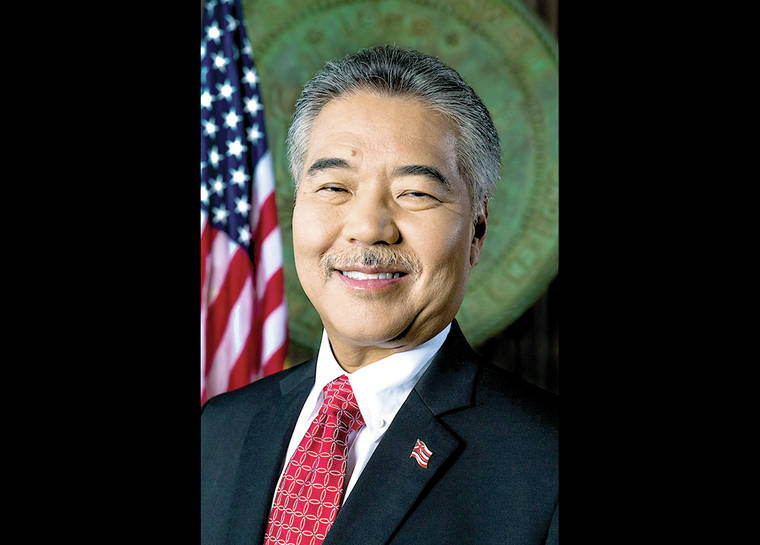Gov. David Ige indicated Monday the Sept. 1 date to allow trans-Pacific air travel without a 14-day quarantine for visitors who get a negative COVID-19 test prior to boarding a Hawaii-bound plane isn’t written in stone.
“I’m aware that the hotels have said three- to four-weeks notice is what they would like to see, if not more,” Ige said during an afternoon press conference. “And the airlines would like at least two weeks notice if there is going to be any change. So I will be meeting with the mayors and talking about the current conditions.
“Clearly, we would want to see a stopping of the increase in the numbers of new cases here in the state and, hopefully, begin the trend downward.”
Ige said officials “continue to monitor the conditions here within the state, as well as around the country, and we’ll be making a further determination as we get closer to the Sept. 1 date.”
Appearing before the House Select Committee on COVID-19 Economic and Financial Preparedness earlier in the day, Ige said the state is trying to build “as robust a testing network as we can.”
“We are having discussions with all of the pharmacists and all of the testing entities across the country, as we know it is important,” he said.
There were 207 new cases reported statewide Monday, including two on Hawaii Island.
State Health Director Bruce Anderson said, however, that 114 of those cases are “a result of delayed testing results.”
“Even so, 93 cases is a high number for Hawaii, and we’d like to see that number decrease,” Anderson said. “Our ability to open our schools, welcome college students here and, ultimately, invite visitors to come is going to be contingent upon our maintaining a healthy community.
“I think the rising number of positive cases can be attributed primarily to the lack of physical distancing and letting down your guard.”
Anderson said he went to several Oahu beaches over the weekend and “was amazed at the number of people on the beaches without face coverings who were not physically distancing.”
“People were acting as though there wasn’t a COVID outbreak, a pandemic that we’re dealing with,” he said. “… We must accept the new reality, based on our investigations and the high number of sustained cases, the virus is widespread on Oahu.
“It is fair to say COVID-19 is now endemic. It is entrenched in the community. There is no longer any easily identifiable sources of exposure, in many cases.”
Anderson said he would be meeting with Honolulu officials to “see what more the city can do to address some of the issues that are being raised, associated with gatherings and so forth.”
Earlier in the pandemic, positive test results in Hawaii would be 1% to 2%, but now positive returns are 5% or 6%, Anderson said.
“Anytime it gets over 5%, there’s reason for concern,” he said. “Some of the states where they’re having large outbreaks have rates of over 10% and 12-15%. Obviously, we don’t want to be there.”
Anderson said most test results on Oahu are available within 24 hours and within 48 hours on the neighbor islands.
“Turnaround time is very important, because we don’t know a person’s positive until the test is completed. And that’s when we start our contract tracing,” he said. “So the longer the time it takes to get a test result back, the less effective our contract tracing is.”
Hospitalization rates statewide remain low, and there is still a ready supply of acute- and intensive-care beds and ventilators, Anderson said.
According to Anderson, one of the challenges faced by local health care officials is that about one-third of the cases involve Pacific Islanders, who make up only about 4-5% of the state’s population.
He said that’s for “various reasons, largely due to socioeconomic status.”
Anderson said the disproportionate number of coronavirus-related infections among Pacific Islanders is “not just here on Oahu, it’s on the neighbor islands, as well.”
“We attribute that to cultural differences, people closer to each other,” he said. “Also, often, they’re working front line in the service industry. … They often have jobs where they can’t … work from home. So there’s a number of risk factors they have that others don’t. … Certainly, there’s no reason to think, otherwise, they’re more susceptible.”
According to Anderson, another factor among Pacific Islanders is “distrust of government.”
“Many of them have been wronged in the past. And I think there’s still a lot of concern about whether … to believe what government’s saying,” he said.
He said outreach workers take interpreters into those communities, and added that inroads have been made by working through their leaders to help gain their trust.
Those high numbers among Pacific Islanders don’t include Native Hawaiians, Anderson said.
“Actually, Native Hawaiians … have a lower rate than you would expect, given their percentage of population here,” he said.
Email John Burnett at jburnett@hawaiitribune-herald.com.





